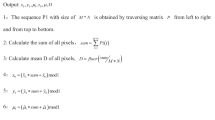Abstract
The purpose of this research is to develop a highly secured non-breakable fastest cryptosystem. A significant number of image encryption plans have been proposed during the past years. By far, most such plans arrive at a high-security level; be that as it may, their moderate velocities due to their complex phenomenon make them of no utilization progressively applications. Motivated by this, we propose another proficient and quick image encryption plan subject to the trigonometric turbulent guide. In contrast with most current plans, we utilize this basic map to create just a couple of arbitrary rows and columns in the form of S-boxes. Besides, to, moreover, accelerate, we raise the handling unit from the pixel level to the line/segment level. Security of the new plan is acquired through a replacement stage organization, where we implemented around the shift of lines and segments to break the strong relation between adjoining pixels and non-repeating sequences. By then, we join the Exclusive-OR operation with modulo capacity to cover the pixel esteems and avoid any spilling of information. High-security tests and reenactment examinations have been done to display that the plan is extremely safe and particularly speedy for continuous picture preparation at 80 fps (frames per second). The present research has developed a cryptosystem based on Exclusive-OR with S-box (Substitution Box) and trigonometric chaotic map (TCM) of image matrices. High security is achieved due to the non-repeating sequence of the TCM. Earlier, the author has already presented the efficacy of the TCM combined with the S-Boxes.











Similar content being viewed by others
Data availability
Enquiries about data availability should be directed to the authors.
References
Abd-El-Hafiz SK, Radwan AG, AbdEl-Haleem SH (2015) Encryption applications of a generalized chaotic map. Appl Mathemat Inform Sci 9(6):3215–3233
Abu-Amara F (2018) Image encryption using trigonometric chaotic map. J Adv Res Dyn Control Syst 10(13):230–237
Abu-Amara F, Abdel-Qader I (2013) Chaotic image encryption via convex sinusoidal map. WSEAS Trans Signal Process 9(4):177–184
Agarwal S (2018) Secure image transmission using fractal and 2D-chaotic map. J Imaging 4(1):17
Bano M, Shah TM, Shah T (2016a) Genetic algorithm on piecewise linear chaotic map bases image encryption. Indian J Sci Technol 9(8):1–7
Bano M, Shah T, Talat R, Shah TM (2016b) Image reconstruction and text embedding using graph cut. Sci Int 28(2):905–911
Bano M, Shah T, Talat R, Shah TM (2017) Image reconstruction and text embedding using scan patterns with XOR in graph cut technique. J Intell Fuzzy Syst 33(2):1097–1104
Bano M, Abdullah S, Shah TM, Panityakul T, Chinram R (2020) An extended image encryption with Markov processes in solutions images dynamical system of non-linear differential equations. J Mathemat Comput Sci 10(6):2191–2207
Duan X, Liu J, Zhang E (2019) Efficient image encryption and compression based on a VAE generative model. J Real-Time Image Proc 16:765–773
Guanghui C, Kai H, Yizhi Z, Jun Z, Xing Z (2014) Chaotic image encryption based on running-key related to plaintext. Sci World J 490179:1–9
Jin H, Ashraf S, Abdullah S, Qiyas M, Bano M, Zeng S (2019) Linguistic spherical fuzzy aggregation operators and their applications in multi-attribute decision making problems. Mathematics 7(5):413. https://doi.org/10.3390/math7050413
Khan AA, Qiyas M, Abdullah S, Luo J, Bano M (2019) Analysis of robot selection based on 2-tuple picture fuzzy linguistic aggregation operators. Mathematics 7(10):1000. https://doi.org/10.3390/math7101000
Lawnik M (2017) Generalized logistic map and its application in chaos based cryptography. J Phys: Conf Ser 936(1):012017
Liu L, Miao S (2017) An image encryption algorithm based on Baker map with varying parameter. Multimed Tools Appl 76:16511–16527
Liu L, Hao S, Lin J, Wang Z, Hu X, Miao S (2018) Image block encryption algorithm based on chaotic maps. IET Signal Proc 12(1):22–30
Paar C (2014) Understanding cryptography: a textbook for students and practitioners. Springer, New York
Panityakul T, Bano M, Shah TM, Prangchumpol D (2022) An RGB color image double encryption scheme. Int J Math Comput Sci 17(1):183–194
Qin C, Zhou Q, Cao F, Dong J, Zhang X (2018) Flexible lossy compression for selective encrypted image with image inpainting. IEEE Trans Circuits Syst Video Technol 29(11):3341–3355
Shabir M, Jun YB, Bano M (2010) On prime fuzzy bi-ideals of semigroups. Iran J Fuzzy Syst 7(3):115–128
Sheela S J, Suresh K V, & Tandur D (2017) Secured text communication using chaotic maps. In: 2017 international conference on algorithms, methodology, models and applications in emerging technologies 1–6
Sui L, Duan K, Liang J, Hei X (2014) Asymmetric double-image encryption based on cascaded discrete fractional random transform and logistic maps. Opt Express 22(9):10605–10621
Thinnukool O, Panityakul T, Bano M (2021) Double encryption using trigonometric chaotic map and XOR of an image. Comput Mater Continua. https://doi.org/10.32604/cmc.2021.019153
Yan B, & Bai S (2017) Design of image confusion-diffusion cryptosystem based on vector quantization and cross the chaotic map. In: 2017 2nd international conference on image, vision, and computing 639–644
Zhang X, Feng G, Ren Y, Qian Z (2012) Scalable coding of encrypted images. IEEE Trans Image Process 21(6):3108–3114
Funding
The authors have not disclosed any funding.
Author information
Authors and Affiliations
Contributions
The proposed method enhances the security of messages (images) transmitted via the internet. Which is beneficial for Banking sector, security agencies, society and the individuals working in the field of cybersystem/cryptography/network security.
Corresponding author
Ethics declarations
Competing Interests
The authors have not disclosed any competing interests.
Additional information
Publisher's Note
Springer Nature remains neutral with regard to jurisdictional claims in published maps and institutional affiliations.
Rights and permissions
Springer Nature or its licensor (e.g. a society or other partner) holds exclusive rights to this article under a publishing agreement with the author(s) or other rightsholder(s); author self-archiving of the accepted manuscript version of this article is solely governed by the terms of such publishing agreement and applicable law.
About this article
Cite this article
Chinram, R., Bano, M., Habib, U. et al. Highly secured and quickest image encryption algorithm based on trigonometric chaotic map and S-box. Soft Comput 27, 11111–11123 (2023). https://doi.org/10.1007/s00500-023-08493-2
Accepted:
Published:
Issue Date:
DOI: https://doi.org/10.1007/s00500-023-08493-2




